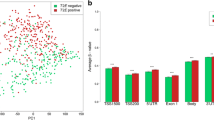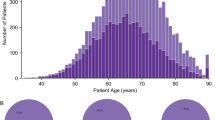Abstract
Complex molecular changes that occur during prostate cancer (PCa) progression have been described recently. Whole genome sequencing of primary PCa samples has identified recurrent gene deletions and rearrangements in PCa. Specifically, these molecular events disrupt the gene loci of phosphatase and tensin homolog (PTEN) and membrane-associated guanylate kinase inverted-2 (MAGI2). In the present study, we analyzed the expression profile of MAGI2 gene in a cohort of clinical PCa (n = 45) and benign prostatic hyperplasia (BPH) samples (n = 36) as well as three PCa cell lines. We also studied the expression of PCa-related genes, including PTEN, NKX3.1, SPINK1, DD3, AMACR, ERG, and TMPRSS2-ERG fusion in the same samples. The expression of MAGI2 mRNA was significantly down-regulated in PC3, LNCaP and DU-145 PCa cell lines (p = 0.000), and also in clinical tumor samples (Relative expression = 0.307, p = 0.002, [95 % CI 0.002–12.08]). The expression of PTEN, NKX3.1, SPINK1, DD3, and AMACR genes was significantly deregulated in prostate tumor samples (p range 0.000–0.044). A significant correlation was observed between MAGI2 and NKX3.1 expression in tumor samples (p = 0.006). Furthermore, the inclusion of MAGI2 in the gene panel improved the accuracy for discrimination between PCa and BPH samples with the sensitivity and specificity of 0.88 [CI 0.76–0.95] and 0.83 [CI 0.68–0.92], respectively. The data presented here suggest that MAGI2 gene can be considered as a novel component of gene signatures for the detection of PCa.



Similar content being viewed by others
References
Carver BS, Tran J, Gopalan A, Chen Z, Shaikh S, Carracedo A, Alimonti A, Nardella C, Varmeh S, Scardino PT, Cordon-Cardo C, Gerald W, Pandolfi PP (2009) Aberrant ERG expression cooperates with loss of PTEN to promote cancer progression in the prostate. Nat Genet 41(5):619–624
King JC, Xu J, Wongvipat J, Hieronymus H, Carver BS, Leung DH, Taylor BS, Sander C, Cardiff RD, Couto SS, Gerald WL, Sawyers CL (2009) Cooperativity of TMPRSS2-ERG with PI3-kinase pathway activation in prostate oncogenesis. Nat Genet 41(5):524–526
Berger MF, Lawrence MS, Demichelis F, Drier Y, Cibulskis K, Sivachenko AY, Sboner A, Esgueva R, Pflueger D, Sougnez C, Onofrio R, Carter SL, Park K, Habegger L, Ambrogio L, Fennell T, Parkin M, Saksena G, Voet D, Ramos AH, Pugh TJ, Wilkinson J, Fisher S, Winckler W, Mahan S, Ardlie K, Baldwin J, Simons JW, Kitabayashi N, MacDonald TY, Kantoff PW, Chin L, Gabriel SB, Gerstein MB, Golub TR, Meyerson M, Tewari A, Lander ES, Getz G, Rubin MA, Garraway LA (2011) The genomic complexity of primary human prostate cancer. Nature 470(7333):214–220
Ding Z, Wu CJ, Chu GC, Xiao Y, Ho D, Zhang J, Perry SR, Labrot ES, Wu X, Lis R, Hoshida Y, Hiller D, Hu B, Jiang S, Zheng H, Stegh AH, Scott KL, Signoretti S, Bardeesy N, Wang YA, Hill DE, Golub TR, Stampfer MJ, Wong WH, Loda M, Mucci L, Chin L, DePinho RA (2011) SMAD4-dependent barrier constrains prostate cancer growth and metastatic progression. Nature 470(7333):269–273
Hu Y, Li Z, Guo L, Wang L, Zhang L, Cai X, Zhao H, Zha X (2007) MAGI-2 Inhibits cell migration and proliferation via PTEN in human hepatocarcinoma cells. Arch Biochem Biophys 467(1):1–9
Tolkacheva T, Boddapati M, Sanfiz A, Tsuchida K, Kimmelman AC, Chan AM (2001) Regulation of PTEN binding to MAGI-2 by two putative phosphorylation sites at threonine 382 and 383. Cancer Res 61(13):4985–4989
Engelman JA (2009) Targeting PI3 K signalling in cancer: opportunities, challenges and limitations. Nat Rev Cancer 9(8):550–562
Wu X, Hepner K, Castelino-Prabhu S, Do D, Kaye MB, Yuan XJ, Wood J, Ross C, Sawyers CL, Whang YE (2000) Evidence for regulation of the PTEN tumor suppressor by a membrane-localized multi-PDZ domain containing scaffold protein MAGI-2. Proc Natl Acad Sci USA 97(8):4233–4238
Sachdeva M, Wu H, Ru P, Hwang L, Trieu V, Mo YY (2011) MicroRNA-101-mediated Akt activation and estrogen-independent growth. Oncogene 30(7):822–831
Shen MM, Abate-Shen C (2010) Molecular genetics of prostate cancer: new prospects for old challenges. Genes Dev 24(18):1967–2000
Kumar A, Shendure J, Nelson PS (2011) Genome interrupted: sequencing of prostate cancer reveals the importance of chromosomal rearrangements. Genome Med 3(4):23
Groskopf J, Aubin SM, Deras IL, Blase A, Bodrug S, Clark C, Brentano S, Mathis J, Pham J, Meyer T, Cass M, Hodge P, Macairan ML, Marks LS, Rittenhouse H (2006) APTIMA PCA3 molecular urine test: development of a method to aid in the diagnosis of prostate cancer. Clin Chem 52(6):1089–1095
Laxman B, Morris DS, Yu J, Siddiqui J, Cao J, Mehra R, Lonigro RJ, Tsodikov A, Wei JT, Tomlins SA, Chinnaiyan AM (2008) A first-generation multiplex biomarker analysis of urine for the early detection of prostate cancer. Cancer Res 68(3):645–649
Rice KR, Chen Y, Ali A, Whitman EJ, Blase A, Ibrahim M, Elsamanoudi S, Brassell S, Furusato B, Stingle N, Sesterhenn IA, Petrovics G, Miick S, Rittenhouse H, Groskopf J, McLeod DG, Srivastava S (2010) Evaluation of the ETS-related gene mRNA in urine for the detection of prostate cancer. Clin Cancer Res 16(5):1572–1576
Livak KJ, Schmittgen TD (2001) Analysis of relative gene expression data using real-time quantitative PCR and the 2(-Delta Delta C(T)) Method. Methods 25(4):402–408
Dhanasekaran SM, Barrette TR, Ghosh D, Shah R, Varambally S, Kurachi K, Pienta KJ, Rubin MA, Chinnaiyan AM (2001) Delineation of prognostic biomarkers in prostate cancer. Nature 412(6849):822–826
Pfaffl MW, Horgan GW, Dempfle L (2002) Relative expression software tool (REST) for group-wise comparison and statistical analysis of relative expression results in real-time PCR. Nucleic Acids Res 30(9):e36
Bastola DR, Pahwa GS, Lin MF, Cheng PW (2002) Downregulation of PTEN/MMAC/TEP1 expression in human prostate cancer cell line DU145 by growth stimuli. Mol Cell Biochem 236(1–2):75–81
Varambally S, Cao Q, Mani RS, Shankar S, Wang X, Ateeq B, Laxman B, Cao X, Jing X, Ramnarayanan K, Brenner JC, Yu J, Kim JH, Han B, Tan P, Kumar-Sinha C, Lonigro RJ, Palanisamy N, Maher CA, Chinnaiyan AM (2008) Genomic loss of microRNA-101 leads to overexpression of histone methyltransferase EZH2 in cancer. Science 322(5908):1695–1699
Brenner JC, Chinnaiyan AM (2011) Disruptive events in the life of prostate cancer. Cancer Cell 19(3):301–303
Lei Q, Jiao J, Xin L, Chang CJ, Wang S, Gao J, Gleave ME, Witte ON, Liu X, Wu H (2006) NKX3.1 stabilizes p53, inhibits AKT activation, and blocks prostate cancer initiation caused by PTEN loss. Cancer Cell 9(5):367–378
Kim MJ, Cardiff RD, Desai N, Banach-Petrosky WA, Parsons R, Shen MM, Abate-Shen C (2002) Cooperativity of Nkx3.1 and Pten loss of function in a mouse model of prostate carcinogenesis. Proc Natl Acad Sci USA 99(5):2884–2889
Reynolds MA, Kastury K, Groskopf J, Schalken JA, Rittenhouse H (2007) Molecular markers for prostate cancer. Cancer Lett 249(1):5–13
Madu CO, Lu Y (2010) Novel diagnostic biomarkers for prostate cancer. J Cancer 1:150–177
Acknowledgments
This work was funded by Pasteur Institute of Iran (Grant No. 562). The authors would like to thank Ms. M. Saffari at Iranian Biomedical Journal editorial office for her contribution in the final editing of the manuscript.
Author information
Authors and Affiliations
Corresponding author
Rights and permissions
About this article
Cite this article
Mahdian, R., Nodouzi, V., Asgari, M. et al. Expression profile of MAGI2 gene as a novel biomarker in combination with major deregulated genes in prostate cancer. Mol Biol Rep 41, 6125–6131 (2014). https://doi.org/10.1007/s11033-014-3491-0
Received:
Accepted:
Published:
Issue Date:
DOI: https://doi.org/10.1007/s11033-014-3491-0




